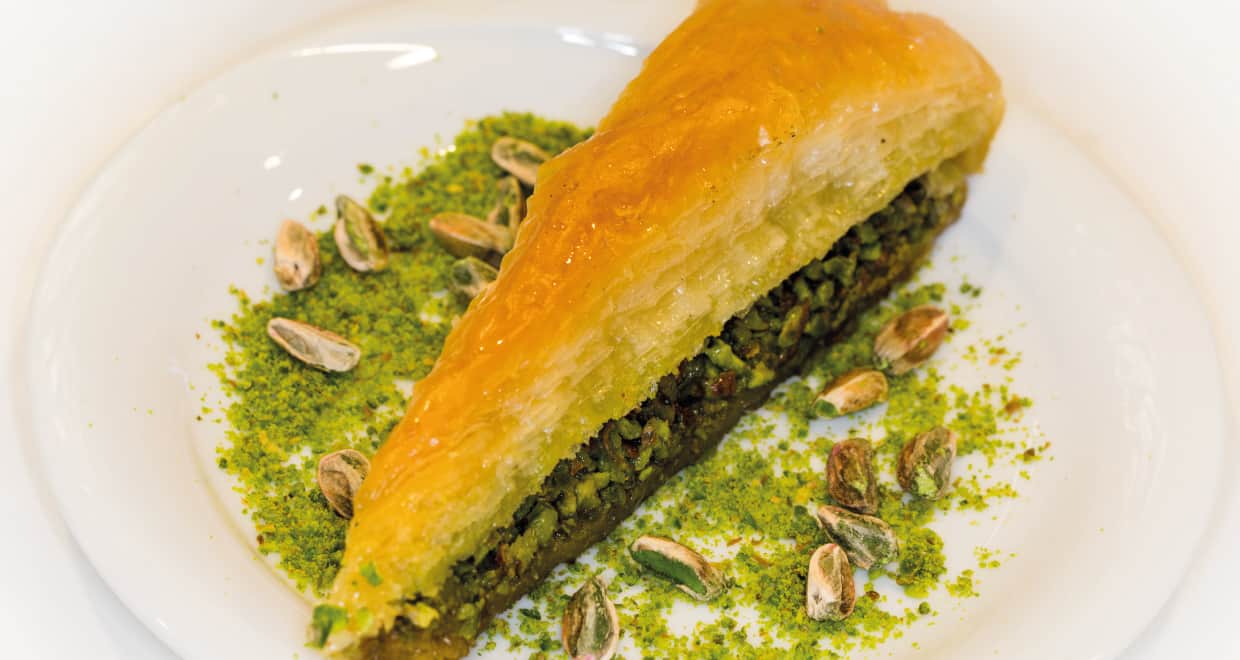Turkish Desserts & Sweets
TURKISH SWEETS & DESSERTS
The most well-known Turkish desserts and sweets associated with Turkish Cuisine are Turkish Delight and “baklava” giving the impression that these may be the typical desserts eaten after meals.This, of course, is not true… Firstly, the family of desserts is much richer than these two. Secondly, these are not typical desserts as part of a main meal. For example, baklava and its relatives are usually eaten with coffee, as a snack or after a kebab dish. Let us now look at the main categories of sweets in the Turkish Cuisine.
By far the most common dessert after a meal is fresh seasonal fruit, acquiring their unique taste from an abundance of sun and old-fashioned ways of cultivation and transportation. Spring will start with strawberries, followed by cherries and apricots. Summer is marked by peaches, watermelons and melons; then, all kinds of grapes ripen in late summer, followed by green and purple figs, plums, apples, pears and quince. Oranges, mandarin oranges and bananas are among the winter fruits. For most of the spring and summer, fruit it eaten fresh. Later it may be used fresh or dried, in compotes or made into jams and preserves.
Among the preserves, the unique ones to taste are the quince marmalade, the sour cherry preserve and the rose preserve (made of rose petals, which is not a fruit!) The most wonderful contribution of Turkish Cuisine to the family of desserts, that can easily be missed by casual explorers, are the milk desserts – the “muhallebi” family. These are among the rare types of guilt-free puddings made with starch and rice flour and originally without any eggs or butter. When the occasion calls for even a lighter dessert, the milk can also be omitted; instead; the pudding may be flavoured with citrus fruits, such as lemon or orange. The milk deserts include a variety of puddings, ranging from the very light and subtle pudding with rose-water to the milk pudding with strands of chickenbreast.
Grain-based desserts include baked pastries, fried yeast-dough pastries and the pan-sauteed desserts. The baked pastries can also be referred to as the baklava family. These are paper-thin pastrysheets that are brushed with butter and folded, layered or rolled after being filled with ground pistachios, walnuts or heavy cream and then baked. Then a syrup is poured over the baked pastries. The various types, such as the Sultan, the nightingale’s nest or the twisted turban differ according to the amount and placement of nuts, size and shape of the individual pieces and the dryness of the final product.
The “lokma” family is made by frying soft pieces of yeast dough in oil and dipping them in a syrup. Lady’s lips, lady’s navel and vizier finger are fine examples.”Helva” is made by pan-sauteeing flour or semolina and pine nuts in butter before adding sugar and milk or water and briefly cooking until these are absorbed. The preparation of helva is conducive to communal cooking. People are invited for “helva conversations” to pass long winter nights. The more familiar tahini helva is sold in blocks at a corner grocery shop.
Another dessert that should be mentioned is a piece of special bread cooked in syrup, topped with lots of walnuts and heavy cream. This is possibly the queen of all desserts, so plan to taste it at the Ikbal Restaurant on the Ankara-Izmir highway at Afyon.
There are shops where baklava, borek or muhallebi are sold, exclusively or in combination. People come to these places for takeaway or to sit down at one of the few tables tucked in a corner of the store. The baklava stores also usually feature “water borek”, an especially difficult borek to make. Most borek shops also make milk puddings. These are excellent places to eat breakfast or lunch at any time of the day, since the regular restaurants may stop serving at two o’clock in the afternoon. Many pudding shops also serve chicken soup.
In any event, it is possible to feast on borek and milk pudding for an entire holiday, if on a tight budget. Perhaps the most well-known shop of this is Saray on Istiklal Street in Beyoglu-Istanbul, in addition to the entire village of Sariyer on the Bosphorus. You have to be in Turkey to get the real and best taste of the above desserts. However, in addition to the variety of Turkish Delights, there is a lesser-known type of dessert that can be taken back home in a sweet box. These are nut pastes – marzipan made of almonds and pistachios. The best marzipan is sold at a tiny, unassuming shop in Bebek in Istanbul. A few boxes usually will last for a month or so and bring delight after dinners. Finally, candied chestnuts, a speciality of Bursa are among the most wonderful nutty desserts.
Learn more about Turkish Cuisine:
- Ottoman Cuisine
- Turkish Mezes
- Baklava – Turkish Sweets
- Seafood Dishes
- Turkish Drinks
- Vegetables & Vegetarian Dishes
Book daily Istanbul sightseeing tours at www.toursistanbul.com
from a range of guided tours.
